During its 61 years in operation, visitors to the annual Daytona Beach Bike Week celebration have taken home countless traffic citations as souvenirs. But Tommy Asberry's memento from the 1971 gathering has to register among the most memorable of all.
"I was ticketed for parking my Harley-Davidson Electra Glide in among all the Hondas and Triumphs on Main Street," said Asberry, 67, of Atlanta (left). "The police told me I couldn't be parking a bike there, leaking oil like that, so I had to move along."
Of course, oil-seeping Harleys are as much a part of the Daytona scene as overpriced beer and cheap T-shirts you'll never wear. Asberry's problem wasn't the color of the 40-weight dripping from his crankcases -- it was the color of his skin.
And like tens of thousands of other black motorcyclists who showed up for -- but were eventually turned away from -- Bike Week during the rally's early years, Asberry eventually found a more hospitable place to park his motorcycle. The social conditions that contributed to bogus traffic tickets and parking citations for black riders may have abated during the last four decades, but Daytona's Second Avenue, a modest three-block collection of Baptist churches, hair-styling salons and funky little bars, continues to thrive.
Ever since the Second Avenue scene emerged out of equal parts bitterness and necessity back in '49 -- centered, at the time, around a tiny ABC liquor store and small enough to take place in the adjacent parking lot -- the rally continues to grow. It now attracts an international mix of riders who, like Second Avenue's founders, come looking for a quieter, more family-oriented alternative to the raucous, corporate-sponsored mayhem of Daytona's Main Street.
Second Avenue is quieter in that you'll find no mega-buck custom-chopper builders showing their wares along the tiny, four-square-block area adjacent to Bethune-Cookman College, and there are few coleslaw wrestlers to be found. You'll more likely find vendors from West African nations selling hand-carved wooden tribal art, bootleg DVD copies of movies still playing at your local multiplex and lots of stick-to-your-ribs food.
Still, Second Street isn't quiet in the literal sense, as the wail of big-bore Japanese drag bikes and open-piped Harleys can be heard well into the night -- that is, if you can hear it over the thump and grind of old-school funk and hip-hop blaring from loudspeakers and passing cars.
Among those who found themselves answering Second Street's subdued siren call was Los Angeles filmmaker Randall Wilson, who shot the documentary Glory Road there for the Corporation for Public Broadcasting during the '01 Bike Week gathering. The acclaimed winner of a Best Documentary award at the Telluride IndieFest for his country-music movie Dixie Rose, Wilson found Second Avenue's laid-back atmosphere a "180-degree turnaround" from the crass commercialism, machismo and silicone-enhanced sexism of Main Street. "With all the small vendors and people yelling hello to folks they hadn't seen in years, Black Daytona, as it's commonly called, reminded me of what old-timers say Bike Week was like before it became another overpriced tractor-pull," Wilson said.
Wilson's independently financed documentary captures the funky, streetwise atmosphere of the Second Avenue rally in detail, from the well-proportioned females riding pillion on stretched and lowered Suzuki Hayabusas to interviews with parents who feel comfortable enough to allow children to play freely among the densely packed motorcycles. Motorcyclist contributor and six-time AMA Prostar champ Rickey Gadson makes an appearance in "Glory Road," along with his mother and longtime Second Avenue visitor, Victoria, who confesses that her famous son "borrowed" her motorcycle as a teen for late-night dragracing. With its emphasis on family, Second Avenue is the sort of rally where riders of all races can feel honored -- rather than embarrassed -- to attend with their parents or grandparents in tow.
"I saw several instances where white bikers would come across Second Avenue by accident, looking for a shortcut back to the main rally. They seemed alarmed at first to see so many black bikers, but once they realized there was a friendly vibe going on, they stuck around," Wilson said.
Although many of the riders attending Second Street's annual gathering wear the traditional black leather vests and three-piece back patches favored by outlaw motorcycle clubs, Wilson found club rivalries and barroom brawls to be virtually nonexistent. "There's none of that 'clubs at war' stuff, and no sexist rhetoric, no one telling women to take their shirts off," Wilson said.
"Instead, I was amazed at how many black women riders had traveled long distances to get there and how they clearly had the full respect of the men. These guys formed motorcycle clubs not to intimidate anybody, but to have somebody to ride with at a time when the outside world could be pretty hostile to bikers, let alone black riders." (Incidentally, Wilson recently filmed a documentary on outlaw motorcycle gangs titled "American Biker.") Also missing is the fierce brand rivalries that dominate today's mega rallies: Honda Gold Wing touring rigs rolled down the Avenue alongside women on customized Harley-Davidson Fat Boys; hip-hoppers in baggy jeans rode Day-Glo Katanas and ZX-6R Ninjas and parked them alongside grizzled bikers on choppers. Riding, not what you ride, is what seems to matter most.
Wilson believes the Second Avenue rally continues today because of the live-and-let-live ethos adopted by its organizers -- that and the gathering's camaraderie, history and small-town atmosphere. "The neighbors will let families park their motor homes in the backyard, and you'll see people cooking out and sharing beers without charging each other $5 apiece. You don't really see that at the big motorcycle rallies anymore," he said.
While Second Avenue's homey atmosphere helps keep the event real, some attendees feel slighted that the Daytona Beach Chamber of Commerce hasn't exactly rolled out the red carpet for them. The bold, "Welcome Bikers" banners hung across Main and Beach Streets are conspicuously absent here.
But some feel an influx of commercialism would only ruin the show. "This isn't all about coming down here and emptying your pockets. It's more like a family reunion and place to kick it with riders you may not have seen for years," said Bill Walker, a member of Atlanta's Zodiacs motorcycle club. In the early '70s, Walker helped found the National Biker's Roundup, a sort of Afro-American take on the annual Black Hills Classic in Sturgis, South Dakota. Like Second Avenue, the Roundup was borne of discrimination and necessity, but it has come to welcome anyone with a taste for soul food, flashy streetbikes and a good time.
Of course, Second Avenue is no different than any other biker rally in that it has a rowdy side. Here, the aggression is mostly relegated to deserted Daytona-area roads in the wee hours of the morning. That's when the stretched and lowered drag bikes so proudly displayed along Second Avenue during daylight hours are raced in clandestine eighth-mile heats. Punters roar in and out of the rally all day, seeking challengers and boasting horsepower figures and what must be exaggerated ETs. By nightfall, it takes a trained ear and generous help from the regulars to find a spot where these covert speed freaks will allow a visitor to watch the rubber hit the road. "A lot of these young guys are serious gunslingers in the street-racing scene," Walker said, "but God help you if you think they'll admit to why they travel this far. Most of them will either go home broke or holding some poor sucker's pink slip."
For Atlanta's Asberry, the years since he filled his Harley's saddlebags with unwarranted traffic tickets are mercifully gone. His annual visits to Bike Week now include stops at Main Street hangouts where he was once made to feel unwelcome or given a police escort back to the segregated confines of Second Avenue. He's amazed at the number of missing limbs and gray beards among his fellow Second Avenue denizens, but Asberry plans to continue making this a permanent stop on his Bike Week itinerary. "There have been a lot of changes down here in the 38 years I've been coming, and most of them have been good ones," he said. "It's a lot more fun than it used to be because everybody gets along and goes where they want. That's why I started coming here in the first place."










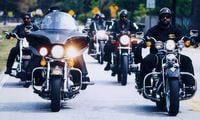



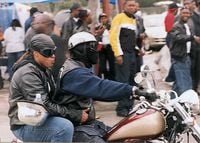
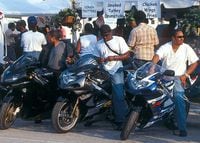

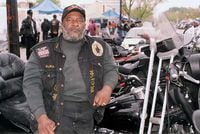


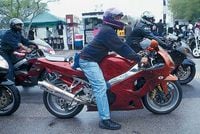
/cloudfront-us-east-1.images.arcpublishing.com/octane/VZZXJQ6U3FESFPZCBVXKFSUG4A.jpg)
/cloudfront-us-east-1.images.arcpublishing.com/octane/QCZEPHQAMRHZPLHTDJBIJVWL3M.jpg)
/cloudfront-us-east-1.images.arcpublishing.com/octane/HXOUJXQWA5HBHGRO3EMJIGFMVI.jpg)

/cloudfront-us-east-1.images.arcpublishing.com/octane/3TIWWRV4JBBOLDVGRYECVVTA7Y.jpg)
/cloudfront-us-east-1.images.arcpublishing.com/octane/KIX5O23D5NAIBGFXBN3327DKZU.jpg)
/cloudfront-us-east-1.images.arcpublishing.com/octane/7GJYDUIPXRGMTMQKN6ONYOLBOU.jpg)
/cloudfront-us-east-1.images.arcpublishing.com/octane/MUQLOVLL2ZDGFH25ILABNBXKTI.jpg)
/cloudfront-us-east-1.images.arcpublishing.com/octane/TNOU5DNE2BC57MFPMGN2EIDXAM.jpg)
/cloudfront-us-east-1.images.arcpublishing.com/octane/GTCXACQGJ5HAPDTGWUQKDEH44E.jpg)
/cloudfront-us-east-1.images.arcpublishing.com/octane/S35YGSEMEZB4BLTDJTSZPF4GLA.jpg)
/cloudfront-us-east-1.images.arcpublishing.com/octane/5UOT6HPX2JFMRJAX6EH45AR4MQ.jpg)
/cloudfront-us-east-1.images.arcpublishing.com/octane/OKWOJWAKP5EP3OACCRRWPCIX2Q.jpg)
/cloudfront-us-east-1.images.arcpublishing.com/octane/2WF3SCE3NFBQXLDNJM7KMXA45E.jpg)
/cloudfront-us-east-1.images.arcpublishing.com/octane/G4MG6OUCJNBSHIS2MVVOTPX65E.jpg)
/cloudfront-us-east-1.images.arcpublishing.com/octane/IIGGWFOTOJGB7DB6DGBXCCMTDY.jpg)
/cloudfront-us-east-1.images.arcpublishing.com/octane/QSTCM6AVEZA5JJBUXNIQ3DSOF4.jpg)
/cloudfront-us-east-1.images.arcpublishing.com/octane/U4I7G625B5DMLF2DVIJDFZVV6M.jpg)
/cloudfront-us-east-1.images.arcpublishing.com/octane/B6XD6LS6IVCQPIU6HXDJSM3FHY.jpg)
/cloudfront-us-east-1.images.arcpublishing.com/octane/ICL63FEDDRDTTMINYICCEYGMDA.jpg)
/cloudfront-us-east-1.images.arcpublishing.com/octane/FCGZHQXRBZFLBAPC5SDIQLVF4I.jpg)
/cloudfront-us-east-1.images.arcpublishing.com/octane/WNOB6LDOIFFHJKPSVIWDYUGOPM.jpg)

/cloudfront-us-east-1.images.arcpublishing.com/octane/X33NU3E525ECRHXLNUJN2FTRKI.jpg)